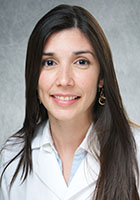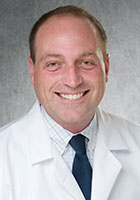We reached out to Andrew Bryant, MD; Jeydith Gutierrez Perez, MD; and Bradley Manning, MD, to offer their perspective on what they witnessed during the initial planning and response to COVID-19 within University of Iowa Health Care. Their responses have been lightly edited.
What changes did you notice in that period of late March and early April? Did things significantly slow down for you?
 Andrew Bryant (AB): We did see a decrease in our general medicine census through mid-May (both teaching and non-teaching services). At the height of our COVID-19 surge in April and May we transitioned two of our non-teaching services to COVID-only. As these patients take more time due to PPE needs, we intentionally lowered the goal census for these COVID-only services. Having a lower census of non-COVID patients helped allow us to do this safely.
Andrew Bryant (AB): We did see a decrease in our general medicine census through mid-May (both teaching and non-teaching services). At the height of our COVID-19 surge in April and May we transitioned two of our non-teaching services to COVID-only. As these patients take more time due to PPE needs, we intentionally lowered the goal census for these COVID-only services. Having a lower census of non-COVID patients helped allow us to do this safely.
 Jeydith Gutierrez Perez (JGP): Definitely there were a lot of changes. At the patient level things slowed down on the wards, we were having less regular acute medicine patients.
Jeydith Gutierrez Perez (JGP): Definitely there were a lot of changes. At the patient level things slowed down on the wards, we were having less regular acute medicine patients.
Nevertheless, the administrative responsibilities, coordination and the effort that took to prepare our response to COVID made things very busy for us in other fronts. Coordinating management strategies with sub-specialist, ensuring that we had similar standards for care, scalation of care and monitoring across hospital units, and coordinating an organized response from all the people involved in the care of COVID patients was no small task. We had great leadership and support from the hospital and our hospital leadership team work tirelessly to guarantee that we were taking good care of all the patients and that we were keeping our staff and patients safe.
 Bradley Manning (BM): Things were much busier for me during March/April- working every day, every weekend for several weeks, had meetings going past 6pm for most of March. I noticed that the leadership was working very hard to get us as prepared as possible for the expected surge- hospital leaders were working the same hours/weekends as I was.
Bradley Manning (BM): Things were much busier for me during March/April- working every day, every weekend for several weeks, had meetings going past 6pm for most of March. I noticed that the leadership was working very hard to get us as prepared as possible for the expected surge- hospital leaders were working the same hours/weekends as I was.
What challenges or successes revealed themselves during that period?
BM: On the hospitalist end, the group created a specific COVID group that was meeting daily as well for hospitalist planning and coordination with HICS (Friederike Fischer, MD; Bryant, Gutierrez, and Ethan Kuperman, MD, were all on that group). I was not taking care of COVID patients myself with HICS responsibilities, but was very proud of the way the group stepped up to care for both the COVID inpatients, using appropriate PPE and excellent teamwork with the MICU and ER, and for outpatients with the Home Treatment Team (HTT). I feel that the hospitalists, gen med floor nurses/staff, and MICU teams role-modeled care of COVID patients for the rest of the hospital. They took care of patients in a safe manner, but understood that it is our duty to take care of these patients.
JGP: Caring for patients with COVID has been an interesting experience and has brought up so much of the “art” of medicine. Patients admitted to the hospital are isolated, unable to receive visitors, unable to leave their room, fearful of their outcome seeing the terrible news about COVID on TV. On top of that they had economic worries, concerns about their loved ones getting sick, etc. We developed a “mental health toolkit” provided them with activity books, we collected book donations so the patients could receive book to keep their minds occupied during their stay. We work with PT, Recreational therapy, patient library and other resources to reinvent the way that those services were provided while still limiting exposure and preserving PPE [personal protective equipment]. Particularly my hardest moment in the COVID unit was when we had to hold a tablet for a family member to say their goodbyes to their loved ones. It was heartbreaking, but nurses, nursing assistants, palliative care and everybody step up to provide support and company for those patients who were dying without their families around.
[On the HTT] We dove right into uncharted waters for us, taking care of patients at home. We are hospitalists and we are used to caring for people admitted to the hospital. Our program took the initiative to follow COVID patients at home almost on a daily basis and guarantee they were progressing well on their illness, or bring them promptly to the hospital if they were not. This team, led by Andy Bryant and Brad Manning, together with the ILI clinic, basically lifted the heavy weight of caring for COVID patients in our community. Their success and ability to create such an organized system, provide patients with excellent care and distribute the workload among providers is amazing. In addition, I’m certain that the HTT played a significant role in patient outcomes. We can say that it saved lives. By contacting and monitoring patients vitals at home we were able to bring through the HTT multiple patients with severe hypoxia that required higher level of care, but would have otherwise stayed at home, possibly much longer.
How did you and your team respond to issues surrounding PPE guidelines and availability?
AB: Our teams responded well. Challenges involved getting everyone in a large department to stay up-to-date on rapidly evolving guidelines for PPE utilization. For example, when the change was made to allow providers to not change their gown/face mask when seeing COVID-19 patients back to back. Ensuring consistency amongst the department was difficult, but we were able to accomplish the goal.
Our hospitalist and [4 South and 5 South] nursing teams bought in to the face shields quickly. This added protection from droplets and deterrent for inadvertently touching your own face was well appreciated by everyone.
JGP: We received great guidance and support from the hospital administration and epidemiology. Initially there was a lot of anxiety among our families and some colleagues regarding lack of PPE knowing that we are the front line caring for COVID patients. Changing guidelines created confusion at times. But all of our providers assumed their role with courage. Thankfully, anxiety and especially fears among their/our families dissipated as we were reassured that we had enough PPE, that we were well protected and supported. I’m really thankful for the efforts of the hospital leadership and our hospitalist program to communicate, timely and effectively to address any of the concerns that we raised regarding PPE.
What impact did restrictions and precautions have on education? How did you adapt to ensure trainee learning could continue?
JGP: Unfortunately our medical students were sent home from the ward. I would have liked to involve them on bedside rounds using a telehealth application, but unfortunately the systems were not in place to do that. Zoom was used to provide formal teaching and hold the Evidence-based medicine sessions that we have for the sub-Is and they were able to continue to do so.
AB: One of the detrimental effects of the COVID precautions/PPE has been bedside teaching. Combining the necessity of social distancing with the inability to hear each other well in the face shields, bedside teaching is not feasible currently. Many of us transitioned to providing more topic-based education in the team rooms (chalk talks and visual learning).
BM: In terms of the general medicine floor experience, the education experience remained close to baseline (since the floor COVID patients were cared for by the hospitalists). Obviously, the format of rounds and resident teaching had to change, but it appears all adapted well. In terms of the MICU, it was challenging for the residents since the MICU population was almost entirely COVID for 2 months, so education was limited management of respiratory failure and other complications in the setting of COVID. The residents took care of these patients bravely and effectively.
I do think that the learning for our MICU residents during COVID transcends disease processes and medical “facts.” They learned how to work together as a team in extremely challenging and even dangerous circumstances, they learned how to adapt to a new disease that we didn’t entirely understand, they learned how to communicate with families despite unprecedented restrictions. I hope that they are able to carry these lessons with them for the rest of their careers, because I saw truly remarkable work from our trainees during this time.
Final thoughts?
JGP: The UIHC response to COVID pandemic was impressive, well-orchestrated and allowed each and everyone of us to assume additional responsibilities to guarantee the safety of our patients and our staff. I marveled at the quick smart solutions that were implemented, the willingness to collaborate and the collegiality. I’m extremely proud to be part of this family.